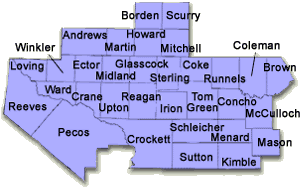Region F
2005 Regional Water Plan Overview

Regional Facts

Major Cities | San Angelo, Odessa, Midland |
| Population: 2000 | 578,814 |
| Population: 2060 | 724,094 |
| Total Water Use: 2000 | 597,636 Acre-Feet |
| Total Water Use: 2060 | 827,397 Acre-Feet |
| Primary Rivers | Colorado, Rio Grande |
| Major Aquifers | Edwards-Trinity Plateau, Cenozoic, Pecos Alluvium, Ogallala |
| Annual Precipitation | 8-23 Inches |
| Net Evaporation | 36-68 Inches |
Basic Plan Facts
- Population growth by 2060 in Region F is projected to be moderate
- Total capital cost of proposed water supply measures: Not Available
- No new reservoirs proposed
What's at Issue?
While water use is not expected to increase dramatically over the planning period, the region is proposing to increase the development of groundwater resources to meet future demands. In many parts of the region, groundwater availability is based on the volume of annual recharge plus a certain percentage of the groundwater stored in the aquifer. This type of management will eventually lead to a situation where future generations may not have reasonable access to groundwater. Also at risk are the numerous springs in the area that support wildlife habitat, including five supporting endangered/threatened species.
Action Items
Here are some of the items the Region F Planning Group must address.
 Conservation and Drought Management
Conservation and Drought Management
For conservation and drought management, the plan needs to...
- Evaluate the high average per capita use in the region and look at the potential of increasing the conservation goal for the region. For example, the average per capita water use for the Region, which is estimated to be 205 gpcd in 2010, is projected to decrease only to 194 gpcd in 2060. This is much higher than the projected statewide average of 162 gpcd and the recommended usage of 140 gpcd by the Conservation Implementation Task Force.
- The plan does not include drought management as a water management strategy. Each water user group with a shortage should use a drought management strategy derived from its drought management plan as a way to meet their water needs. The regional plans in the state are based on a drought of record and it only makes sense that drought management should play a large role in planning to meet the region's water needs during that drought period.
 Environmental Flows
Environmental Flows
To secure the protection of flows for fish and wildlife, the plan needs to...
- Quantitatively evaluate alternative water supply strategies for effects on environmental flows.
- Identify habitats associated with both major and non-major springs and include information on how aquifer drawdown affects spring flows.
- Designate stream segments in the region that meet the criteria as having "unique ecological value". The Texas Parks and Wildlife Department recommends 21 segments for designation in this region.
 Wildlife Habitat and Farmland Protection
Wildlife Habitat and Farmland Protection
To avoid destroying valuable wildlife habitat and productive farmland, the plan needs to...
- Avoid recommending construction of unnecessary reservoirs.
 Groundwater Management
Groundwater Management
To ensure the long term viability of the state's groundwater resources, the plan needs to...
- Adopt a goal of true sustainability for the region's aquifers where average groundwater withdrawals do not exceed a rate which can be replenished through recharge on a continual basis while maintaining adequate spring flows and encourage and support the region's groundwater conservation district efforts to move towards it.



 Region F
Region F